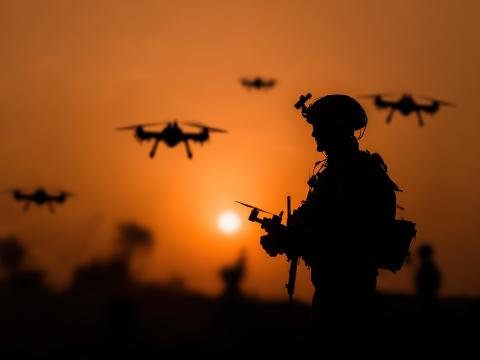DISA Supports Warfighter Lethality
Despite the global pandemic, the Defense Information Systems Agency (DISA) has never stopped providing warfighters with critical connections needed to conduct multidomain warfare and never let up on the daily battles in cyberspace, says Vice Adm. Nancy Norton, USN, the agency’s director and the commander of Joint Forces Headquarters for the Department of Defense Information Systems Network.
Adm. Norton made the comments during an AFCEA TechNet Cyber webinar on November 5. The webinar is part of a series of webinars leading up to the TechNet Cyber conference scheduled for December 1-3.
Among other global activities in support of the armed forces, the agency’s Defense Spectrum Organization is modernizing its applications “to ensure freedom of action across the electromagnetic spectrum,” she reported. DISA’s electromagnetic spectrum situational awareness capability will receive an upgrade that provides a complete picture of the electromagnetic spectrum environment and spectrum operations being conducted.
In addition, the Defense Spectrum Organization is “developing a joint electromagnetic battle management capability that will allow joint command and control of electromagnetic spectrum operations,” she added. “These initiatives provide warfighters with the information they need to decide how best to use their assets to ensure mission success,” Adm. Norton stated.
Additionally, the DISA field offices of Special Operations Command and Africa Command work to build up the infrastructure to support secure telecommunications for U.S. Special Operations Command-Africa and Africa Command to communicate with their forward deployed locations, often in austere environments. “They assisted in accelerating an upgrade to a combatant command’s connections to the DISA virtual private network. These circuit upgrades allowed [Special Operations Command] to increase users’ access globally to the special operations force enterprise classified network,” she reported.
Also, DISA’s Airborne Intelligence, Surveillance and Reconnaissance (ISR) program supports video and sensor dissemination, tactical relays, ISR ground stations and ISR network operations. The ISR enterprise is used by the combatant commanders to make decisions to support combat, rescue and other missions with near-real time information at their disposal.
Multiple ISR ground stations strategically placed throughout the world are managed by DISA, the military services and select combatant commands. The ground stations serve as a direct interface for the ISR platforms into the Defense Information Systems backbone that feeds into the Unified Video Dissemination System, or UVDS.
“The ISR program has deployed multiple Stingray systems into the Africa Command theater and elsewhere. The tactical systems are the direct interface to unmanned platforms that relay that sensor data and video back to the ground stations,” she explained. And then UVDS provides access to live, full-motion video for members of the global U.S. intelligence community. UVDS is a transport and storage capability that supports near real-time video streaming of manned and unmanned ISR platforms,” the DISA director added.
The system is located in the European Command and Africa Command areas of responsibility to reduce the overall video latencies experienced by the users who previously had to reach back into data centers located in the continental United States. “The UVDS systems in theater improve the warfighters’ ability to obtain an understanding of the battlespace much faster,” Adm. Norton noted.
Furthermore, the agency’s Infrastructure Directorate installed, implemented and activated a refreshed telecommunications transport infrastructure in South Korea that aligns with the Defense Information Systems Network global enterprise design. The architecture backbone expands the network and provides upgraded routers in support of the Army. The capability provides an improved, reliable, redundant and resilient communications infrastructure in a critical operating area.
DISA’s Procurement Services Directorate also supports warfighters, working with mission partners to acquire Iridium mobile phones that increase the ability for U.S. forces to have satellite communications in austere environments.
And earlier this year, the agency personnel in Guam provided support to the USS Theodore Roosevelt while it was in port at Naval Base Guam, giving a pier-side connection for the network.
Moreover, DISA’s Global Command and Control System-Joint, or GCCS-J, is used every day worldwide on the U.S. and coalition networks at the strategic operational and tactical levels to provide an integrated, near real-time common operational picture. “GCCS-J supports mission areas, including global situational awareness, missile warning, friendly force tracking, intelligence support to command and control, freedom of navigation, humanitarian assistance, disaster relief, counter narcotics, drug interdiction, search and rescue and shared data with coalition partners,” Adm. Norton said.
DISA has been working diligently to upgrade the bandwidth within the Indo-Pacific region, too.
Adm. Norton also touted the agency’s herculean efforts to provide secure teleworking capabilities during the worldwide COVID-19 pandemic. She specifically cited the agency’s efforts in the Indo Pacific region. “Since we’ve been in this maximum-bit telework situation, some of the bandwidth utilization for some of our Internet access points peaked, but DISA extradited a bandwidth upgrade at our two Pacific Internet access points that allowed mission partners to upload and download larger amounts of data quickly without experiencing service degradations,” she reported.
More generally, the agency implemented its Cloud-Based Internet Isolation program to allow warfighters and those who support them to have necessary access to information on the web while protecting the network.
“CBII, as we refer to it, eliminates web-based threats from Internet downloads. The technology removes the browsing process from the user’s desktop and moves it into the cloud, effectively creating a secure environment between the Internet and the Department of Defense Information Network, and it also reduces bandwidth associated with browsing,” she reminded the audience.
Implementing the CBII helped DISA enable the Defense Health Agency’s telehealth program when they needed it the most, and it also allowed missileers on long duty rotations established to meet new quarantine requirements to have much needed access during their downtime.
“During this unprecedented time, DISA has ramped up to provide faster, more secure capabilities to the department and the warfighter. In this multi-domain warfare environment, DISA provides support to allow our warfighters to provide timely information sharing, to defeat, deter and to win against the adversary before and during the pandemic,” Adm. Norton stated.





Comments